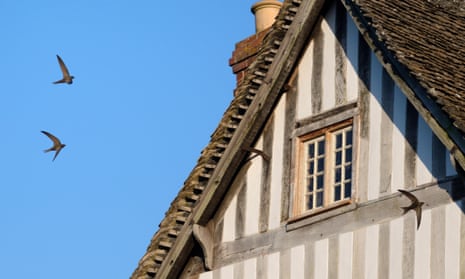The number of swifts that returned to Britain from their wintering grounds in Africa this spring was the lowest since records began, with poor weather in the Mediterranean delaying their arrival by two weeks. Experts fear the recent wet weather will further hit their numbers. Swift numbers in Britain have fallen by more than 50% since 1995.
More than 100 walks, talks and visits to urban areas to witness the swift’s aerial “screaming parties” will be held this week to raise awareness of the plight of this unique migratory bird.
Nick Brown, a coordinator of Swift Awareness Week, which starts on Saturday, said: “The very cool and wet weather we have had for most of May and June does not suit swifts. They are either incubating their eggs or trying to feed small young and they need warm, dry conditions to find the insects and spiders floating in the air on which they feed.
“Swift Awareness Week aims to raise the profile of this troubled bird and show how easy it is to help by putting up nest boxes for them.”
Swifts can go months or even years entirely airborne, eating insects in flight and sleeping on the wing, only landing when they are mature and ready to nest in the roofs of buildings.
This year poor weather has led to some adult swifts being found grounded and unable to fly, soaking and emaciated from a lack of opportunities to feed on insects. Pictures showed desperate groups of swifts clinging to the vertical walls of buildings to avoid stormy conditions before they reached Britain.
Edward Mayer, a swift expert who runs the Swift Conservation website, said: “There has been some really appalling spring weather this year in Italy, France, Spain and the Balkans. Temperatures should have been in the 30s but were in the low teens, and much lower at night, with prolonged rainstorms making things even worse. This suppresses the swifts’ flying insect food, soaks and chills them – and can kill them.”
Apart from the loss of flying insects, one of the main threats facing swifts in Britain is the renovation of older properties. Energy efficiency measures have blocked holes in roofs and under tiles, where they make their nests. New buildings rarely make provisions for swifts or other roof-nesting species such as bats, unless special boxes are added.
The RSPB, which is supporting Swift Awareness Week, said it sold more than 1,000 swift nestboxes in the spring to homeowners wanting to help the birds.
According to an article in the Chartered Institute for Ecology and Environmental Management’s journal recently, energy-efficient new buildings can easily accommodate homes for swifts inside wall cavities. “Nest bricks” containing small holes can be added in small clusters of two to four to gables of houses. Swifts prefer to nest close to one another.
Chris Packham’s People’s Manifesto for Wildlife has called on the government to introduce new building regulations to ensure every development includes swift nest bricks.
A grassroots network of local swift groups are offering free guided walks and talks for Swift Awareness Week everywhere from Aberdeenshire to Truro, including Morpeth, Kinross, Sedburgh, Oxford, Holyhead and Hackney.
People are being encouraged to record their sightings on the RSPB’s website to aid tracking.
